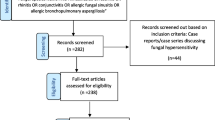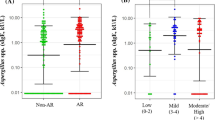Summary
Throughout the years, pollen has been widely studied as an aeroallergen, but less is known about fungal spores.
It has long been established that fungal spores are present in the atmosphere in high concentration, considerably in excess of pollen grains, but the debate regarding their potential allergenicity is far from resolved. Although there is an agreement among allergists that inhaled fungi are responsible for production of upper and lower respiratory tract symptoms there is a paucity of data on the actual incidence of respiratory allergy induced by inhaled fungal spores.
Although positive immediate and delayed skin reactivity is obtained with crude extracts of many fungal species, the clinical relevance of the reactivity is often uncertain and the contribution of fungal allergens to production of symptoms in any given patient is often difficult to assess. This is due to many factors, among which are the following: 1) The choice and method of preparing fungal extracts for skin testing and provocative challenge has varied markedly among investigators and there are nearly as many allergen extraction and isolation procedures as there are researchers and commercial suppliers of allergens. 2) There is much variability in the antigen/allergen content of extracts. For this reason the quality and potency of mould allergenic extracts has often been poor and variable. For the standardization of extracts the allergens of moulds need to be elucidated. 3) Relatively few organisms have been studied in detail, and many common fungi still need initial clinical evaluation. 4) A single, well-defined, mould season usually does not occur, making it especially difficult to select a study population with unique seasonal mould allergy.
Riassunto
In allergologia clinica la sensibilizzazione da miceti ha un ruolo di importanza secondaria rispetto a quella da pollini, ma le nostre conoscenze sul ruolo allergenico delle spore e di altre emanazioni atmosferiche dei miceti sono però stato largemente insoddisfacenti.
Contrariamente a quanto avviene per i granuli pollinici, la cui sede di origine, la pianta che li produce, è ben visibile nell'ambiente, per le spore dei miceti è frequentemente impossibile evidenziare la sorgente fungina di appartenenza. Maggiore importanza assumono quindi l'identificazione e la misura della loro concentrazione nell'atmosfera.
Il campionamento aerosporologico può essere effettuato con apparecchi volumetrici tipo Hirst che permettono però il solo riconoscimento di alcune spore e non di altre, come quelle di Aspergilli e Penicilli. Per quest'ultime appare più utile la captazione mediante capsule di Petri esposte isolatamente o in un apparecchio campionatore a multistadi del tipo dell'Andersen. Per quanto riguarda i riflessi in allergologia clinica la scarsa frequenza di sensibilizzazione da miceti è verosimilmente da collegare alla carente purificazione e standardizzazione degli estratti allegenici utilizzati. Non esiste infatti un'uniformità nei metodi di estrazione delle componenti allergeniche e quindi c'è molta variabilità nel contenuto antigenico ed allergenico degli estratti di ditte diverse o della stessa ditta in tempi diversi. C'è inoltre da considerare che, contrariamente a quanto avviene per i pollini, non esiste per i miceti una ben definita stagione di presenza ambientale di spore fungine sì da consentire una correlazione con la sintomatologia clinica. La stagione fungina dell'atmosfera libera è infatti frequentemente integrata dalla presenza delle stesse spore all'interno delle abitazioni e/o degli ambienti di lavoro per cui l'esposizione diventa di tipo perenne.
Similar content being viewed by others
Bibliografia
Adams K.F., Hyde H.A., Collins R., Alexander J., Norman P., (1982) —Basidiospore sensitivity and asthma. J. Allergy Clin. Immunol. 69, 98.
Agarwal M., Jones R., Yunginger J., (1982) —Immunochemical and physiochemical characterization of commercial Alternaria extracts: a model for standardization of mold allergen extracts. J. Allergy Clin. Immunol. 70, 432–436.
Al-Doory Y., Domson J.F., (1984) —Mould Allergy. Lea & Febiger.
Baldo B., (1983) —Standardization of allergens. Allergy 38, 535–546.
Bonilla-Soto O., Rose N., Arbesman C., (1961) —Allergenic molds: antigenic and allergenic properties of Alternaria tenuis. J. Allergy 32, 246–270.
Burge H.A., (1985) —Fungus allergens. Clin. Rev. Allergy 3, 319–331.
Burge H.A., (1986) —Some comments on the aerobiology of fungus spores. Grana 25, 143–146.
D'Amato G., (1981) —Allergia respiratoria da pollini e da miceti. Lombardo Editore, Roma.
D'Amato G., (1984) —Mould allergy in Italy. In «Atlas of Moulds in Europe causing respiratory allergy». Foundation for allergy research in Europe. ASK Publ. 80-82
D'Amato G., Cocco G., Melillo G., (1981) —Immunological effects induced by biological natural aerosols (pollen and spores). Z. Erkrank. Atm. Org. 137, 281–285.
D'Amato G., Stanziola A.A., Cocco G., Melillo G., (1984) —Mold allergy: a three year investigation (1980–1982) of the airborne fungal spores in Naples. Ann. Allergy 52, 363–367.
Gravesen S., (1979) —Fungi as a cause of allergic disease. Allergy 34, 135–154.
Gregory P.H., (1973) —The microbiology of the atmosphere. 2nd Ed. Leonard Hill, Aylesbury, Bucks.
Lehrer S.B., Aukrust L., Salvaggio J.E., (1983) —Respiratory allergy induced by fungi. Clin. Chest Med. 4, 23–29.
Lehrer S.B., Lopez M., Butcher B.T., Olson J., Reed M., Salvaggio J.E., (1986) —Basidiomycete mycelia and spore-allergen extracts: skin test reactivity in adults with symptoms of respiratory allergy. J. Allergy Clin. Immunol. 78, 478–485.
Lopez M., Salvaggio J., Butcher B., (1976) —Allergenicity and immunogenicity of basidiomycetes. J. Allergy Clin. Immunol. 57, 480–488.
Marsh D., Collins R., Santilli J., (1984) —Alt 1 and other major Alternaria allergens are spore-specific. J. Allergy Clin. Immunol. 73 (Suppl.), 114.
Mayer G., Homer P., Warren R., (1983) —Airborne fungi, a resurvey. Ann. Allergy 51, 26–29.
Salvaggio J.E., Aukrust L., (1981) —Mold-induced asthma. J. Allergy Clin. Immunol. 68, 327–346.
Schumacher M., Jeffery S., (1976) —Variability of Alternaria alternata: biochemical and immunological characteristics of culture filtrates from seven isolates. J. Allergy Clin. Immunol. 58, 263–269.
Solomon W.R., (1975) —Assessing fungus prevalence in domestic interiors. J. Allergy Clin. Immunol. 56, 235–240.
Solomon W.R. (1980) —Common pollen and fungus allergens. In «Allergic diseases of infancy, childhood and adolescence». Eds. Warren Bierman C. and Pearlman D.S.-W.B. Saunders Comp. 219–247.
Yunginger J., Jones R., Nesheim M., Geller M., (1980) —Studies on Alternaria allergens. III. Isolation of a major allergenic fraction (Alt. 1), J. Allergy Clin. Immunol. 66, 138–147.
Author information
Authors and Affiliations
Rights and permissions
About this article
Cite this article
D'Amato, G. Difficoltà negli studi aerobiologici ed allergologici sui miceti. Aerobiologia 2, 23–28 (1986). https://doi.org/10.1007/BF02450001
Published:
Issue Date:
DOI: https://doi.org/10.1007/BF02450001




